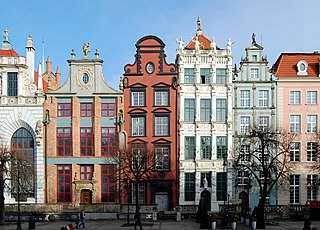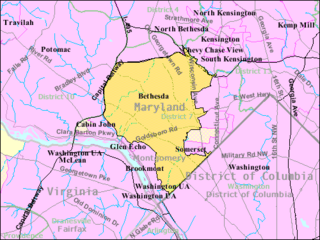
Bethesda is an unincorporated, census-designated place in southern Montgomery County, Maryland, United States, located just northwest of the U.S. capital of Washington, D.C. It takes its name from a local church, the Bethesda Meeting House, which in turn took its name from Jerusalem's Pool of Bethesda. In Aramaic, beth ḥesda means "House of Mercy" and in Hebrew, beit ḥesed means "House of Kindness". The National Institutes of Health main campus and the Walter Reed National Military Medical Center are in Bethesda, as are a number of corporate and government headquarters.

North Bethesda is an unincorporated, census-designated place in Montgomery County, Maryland, United States, located just north-west of the U.S. capital of Washington, D.C. Among its 14 neighborhoods, the centrally-located, urbanizing district of White Flint is the commercial and residential hub of North Bethesda. The WMATA White Flint metro station and Grosvenor-Strathmore metro station serve the region. Four of the National Institutes of Health as well other federal agencies, including the Nuclear Regulatory Commission, the Health Resources and Services Administration, and the United States Public Health Service Commissioned Corps, are headquartered in North Bethesda. A number of corporate headquarters are headquartered in North Bethesda, as well as nonprofits such as the American Kidney Fund, the Society of American Foresters and United States Pharmacopeia (USP).
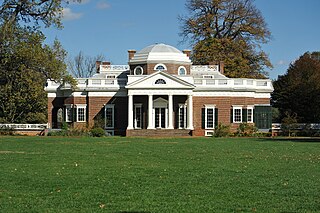
The architecture of the United States demonstrates a broad variety of architectural styles and built forms over the country's history of over four centuries of independence and former Spanish and British rule.

Rockville station is an intermodal train station located in downtown Rockville, Maryland, United States. It is served by the Washington Metro Red Line, MARC Brunswick Line commuter trains, and Amtrak Capitol Limited intercity trains.
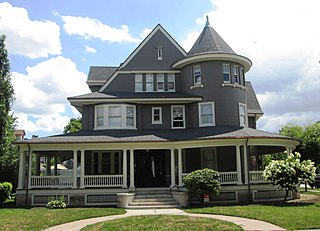
Prospect Park South is a neighborhood in the New York City borough of Brooklyn. It is bordered by Prospect Park and the Prospect Park Parade Ground to the north, Ocean Avenue and the BMT Brighton Line subway tracks to the east, Beverley Road to the south, and Coney Island Avenue to the west.

Wisconsin Avenue is a major thoroughfare in Washington, D.C., and its Maryland suburbs. It starts in Georgetown just north of the Potomac River, at an intersection with K Street under the Whitehurst Freeway. The section of Wisconsin Avenue in Georgetown was called High Street before the street names in Georgetown were changed in 1895 to conform to those of the L'Enfant plan for the federal city.

Waddy Butler Wood was a prominent American architect of the early 20th century and resident of Washington, D.C. Although Wood designed and remodeled numerous private residences, his reputation rested primarily on his larger commissions, such as banks, commercial offices, and government buildings. His most famous works include the Woodrow Wilson House and the Main Interior Building.

Maryland Route 355 (MD 355) is a 36.75-mile (59.14 km) north–south road in western central Maryland in the United States. The southern terminus of the route, Wisconsin Avenue, is located in the Bethesda CDP, at the Washington, D.C. border. It continues south into Washington, D.C. as Wisconsin Avenue NW. The northern terminus is just north of an overpass with Interstate 70 (I-70) and U.S. Route 40 in the city of Frederick in Frederick County, where the road continues north through Frederick towards MD 26.
Roscoe Harold Zook was an American architect best known for his work in suburban Chicago, Illinois. He received a degree in architecture from the Armour Institute of Technology in 1914. In 1916 Zook married his first wife, Mildred Barnard. They divorced in the late 1930s. They had one son, Harold Barnard Zook, who followed in his father's footsteps to become an architect in Corona del Mar, California. In the early 1940s, Zook married his second wife, Florence (Barkey) Nissen, whom he met through mutual friends. Zook died in April 1949, just short of his 60th birthday.

Frederick William ("Fred") Anhalt was a builder and contractor who constructed many distinguished rental apartment buildings in Seattle, Washington in the 1920s and early 1930s. In 1993, the Seattle Chapter of the American Institute of Architects (AIA) awarded Anhalt an honorary membership in recognition of excellence in residential design. In 2001, The Seattle Times listed Anhalt as one of the 150 most influential people in Seattle History His buildings have been referred to as "Castles in Seattle."
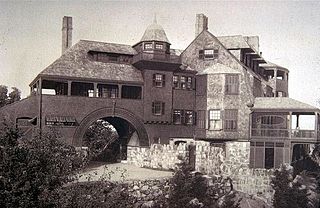
The Shingle style is an American architectural style made popular by the rise of the New England school of architecture, which eschewed the highly ornamented patterns of the Eastlake style in Queen Anne architecture. In the Shingle style, English influence was combined with the renewed interest in Colonial American architecture which followed the 1876 celebration of the Centennial. The plain, shingled surfaces of colonial buildings were adopted, and their massing emulated.

Silver Spring station is a historic building located at Silver Spring in Montgomery County, Maryland on the Metropolitan Subdivision. It was built in 1945 on the foundation of the original station, a Victorian-style brick structure built in 1878. It was designed in the Colonial Revival style and built from standardized plans developed for B&O stations in the mid-1940s. Amtrak's Blue Ridge served the station until it was discontinued in 1986.

Edward Townsend Mix was an American architect of the Gilded Age who designed many buildings in the Midwestern United States. His career was centered in Milwaukee, Wisconsin, and many of his designs made use of the region's distinctive Cream City brick.

The Bushwick Democratic Club House was a notable building located in Brooklyn, New York. The building, designed by Brooklyn-based architect Frank Freeman in his signature Richardsonian Romanesque style, was completed in 1892, and designated a New York City landmark in the 1970s. It was later destroyed by fire.

The Southside Historic District is a large, prestigious historic neighborhood in Racine, Wisconsin, including over 500 contributing structures in various architectural styles. It was added to the National Register of Historic Places in 1977.
Herbert B. Hunter was an architect in North Carolina. Early in his career he worked as a draughtsman for Leonard L. Hunter. His principal North Carolina projects occurring in the 1920s. Hunter established his own firm in High Point, North Carolina in the early 1920s. He was an early member of the North Carolina Chapter of the American Institute of Architects and was pictured among the group at the annual meeting in Charlotte in 1929. He worked as an architect for the National Park Service designing park buildings. President Franklin D. Roosevelt selected him to make the drawing for the White House Oval Room. He served in the U.S. Navy during World War I and World War II, planning hospitals and other structures.

Appleton Prentiss Clark Jr. was an American architect from Washington, D.C. During his 60-year career, Clark was responsible for designing hundreds of buildings in the Washington area, including homes, hotels, churches, apartments and commercial properties. He is considered one of the city's most prominent and influential architects from the late 19th and early 20th centuries. Many of his designs are now listed on the National Register of Historic Places (NRHP).
George Champlin Mason Jr. (1849–1924) was an American architect who is considered the first professional architectural preservationist in the United States.
Gertrude Sawyer was one of the earliest American women architects to practice in Maryland and the Washington, D.C., area.
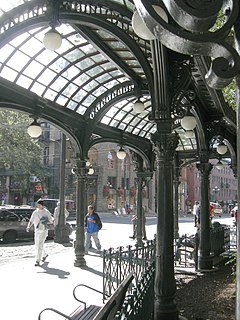
Julian Franklin Everett was an American architect known for the buildings he designed in Seattle, Washington. His work includes a synagogue for the Temple de Hirsch congregation (1908) and the Pioneer Square Comfort Station and Pergola in Seattle (1909), now a historic landmark. Some of his works, including the temple and a building for Pathé Exchange, were later demolished, while others are listed on the National Register of Historic Places (NRHP).


